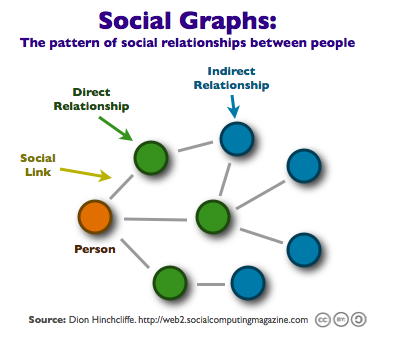Owning Your Social Graph

Even if you use Facebook, Twitter, LinkedIn or MySpace, you might not be aware that you have a “social graph."
It's a term that seems to have come out of Facebook itself as a way to map their social network. Your social graph would be a global map of everyone you're connected to in social networks and how they are related.
If you're active in social media, you know that graph will be... well, a complicated mess.
Some businesses and networks are relying on your ignorance or naivete so that they can mine your personal data and use it for marketing purposes.
Facebook gets a lot of criticism for doing this, but that's because they are big and they are using the data and making money. Twitter doesn't seem to have figured out how to use it to make money yet, but they (or whoever buys them) eventually will figure it out.
You might be unconscious that you are even giving data. It's not just the photo, email or link you share. It's also every time you click that "like" button.
And I am not even getting into “social leverage”, your “online presence”, or gauging “social engagement.”
On readwriteweb.com they discuss how having different logins for different social networks is a problem for tracking this graph. But are you noticing how sites are "asking permission" to connect to other networks? "Can we look at your Gmail contacts and find your friends for you?" Sure. Click, and they have your contacts. Let's hope they're not storing that login info and all your friends information too, because they didn't give permission.
Google is trying to make email the center of your social graph. Facebook wants all thing to emanate from their site.
Privacy - which everyone seems to say is gone, so get over it - is still an issue. Who owns your information? Do we need a Social Bill Of Rights?
Then there's your name space. Another new term. I define it as the center of your social graph. (Though one of my students maintains that her graph has at least three centers - professional, personal and academic.) A Wikipedia search only turns up the computer namespace as an abstract container providing context for items (ex: variables, interfaces, classes, etc.) it holds.
While we are looking at definitions, in mathematics, a graph is an abstraction for modeling relationships between things. So, using it for a network with nodes and edges is a good way to visualize a social network.
Do a Google vanity search on your name. What comes out on the top of the search? Is that your name space? On Google, my top result is a site I control. On Bing, it's my Slideshare presentations - but my Facebook page is number 3 and Twitter is number 4. On Yahoo, Twitter is on top and a site that I don't even use is #2. (Yahoo, what is wrong with your algorithms?) Is that what I want at the top of my name space or at the center of my graph? Not really. Changing the search to my more formal first name, Kenneth, changes the results (favorably). Maybe I need to use that name to control my name space.
Comments
No comments